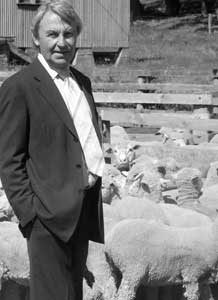|
SAVILE ROW TAKES TO GOLDEN CLOTH
A golden suit is bound to raise a titter or two among a man’s business associates – but a suit in the Golden Fleece is unlikely to raise an eyebrow in sober society and would certainly not frighten the horses.
This Golden Fleece, from dinky sheep of the rare Saxon  breed, is the latest and most luxurious of suiting fibres currently hitting Savile Row and being taken up enthusiastically by those who want the best. breed, is the latest and most luxurious of suiting fibres currently hitting Savile Row and being taken up enthusiastically by those who want the best.
It comes to Savile Row today after a tortuous journey that started in the 11th century. Moors took the hardy sheep of the Atlas mountains in North Africa to Spain. There they were appreciated by no less a personage than King Phillip ll, who kept them at his Escorial Palace and decreed that cloth made from their fleece could only be worn by royalty.
A later king of Spain sent a small flock as a gift to his cousin in Saxony in the 18th  century and, by happy chance, a Scots woman emigrating to Australia in 1829 bought the remains of this flock of pure Saxon sheep and shipped them to Tasmania. century and, by happy chance, a Scots woman emigrating to Australia in 1829 bought the remains of this flock of pure Saxon sheep and shipped them to Tasmania.
Now, just three flocks of Saxon sheep survive, their pedigree guarded jealously, giving the very finest of wool, truly a golden fleece.
Its exceptional quality comes from the unique crimp of the soft wool fleece, ensuring a cloth with 'give' and remarkable powers of recovery. No cloth, or certainly not a fine wool one, is completely crease-resistant but a suit made in Escorial may emerge creased from a long flight but hung up for a few hours will shed those creases.
"Those who have tried it are hooked," says Lindsay Taylor of top cloth merchants, Holland & Sherry, who supply it in cut lengths to the tailors.
Not surprisingly, Escorial is already appreciated by discerning American tailors and their customers, the suit above coming from New York designer Jack Simpson.
THE ESCORIAL STORY
The man who must be credited with saving and establishing this special fleece in the rarefied air of high fashion and luxury clothing is Peter Radford. In the face of not inconsiderable opposition and scepticism in his native Australia and New Zealand, he  has nurtured the breed over the past twenty odd years, promoted the fleece and established the brand name of Escorial for the very top end of its market. has nurtured the breed over the past twenty odd years, promoted the fleece and established the brand name of Escorial for the very top end of its market.
This summer has seen a major campaign underway to get the Escorial message across to more top tailors and fashion designers. Indicative of its reception in Savile Row is that Anderson & Sheppard has presented a suit made in an Escorial cloth in its window display.
From the outset, Peter Radford, seen here with his flock, was determined to control the product all the way through the supply chain, his ultimate goal to see the Escorial brand name on the clothing label. He believes passionately in the unique quality of this wool, and took inspiration from the way the French market their champagne.
Every one of the 50,000 Saxon sheep in Australia and New Zealand is numbered and the bloodlines kept in a Tasmanian register. Output is small - only 20-30 tonnes of fleece for Escorial are produced each year, which is less than one percent of the world’s cashmere production – and the sheep are only sheered once a year.
Now, it is available in the finest suitings from Reid & Taylor, Taylor & Lodge, Robert Noble and William Halstead, in silk jacquards from Stephen Walters, and some unusual designs from Mallalieus of Delph. Holland & Sherry is the leading merchant for Escorial suitings in Savile Row, and has been marketing it in a small but successful way for some years now.
It can double the price of a suit. But Savile Row tailors, a number of whom have been offering Escorial for several seasons, report that customers who have tried the cloth come back and ask for it again.
"It is wonderful to wear," said Simon Cundey of Poole's, "and to work with. Its like working with butter, its so fluid and easy to sew and never rumples or snags.
|